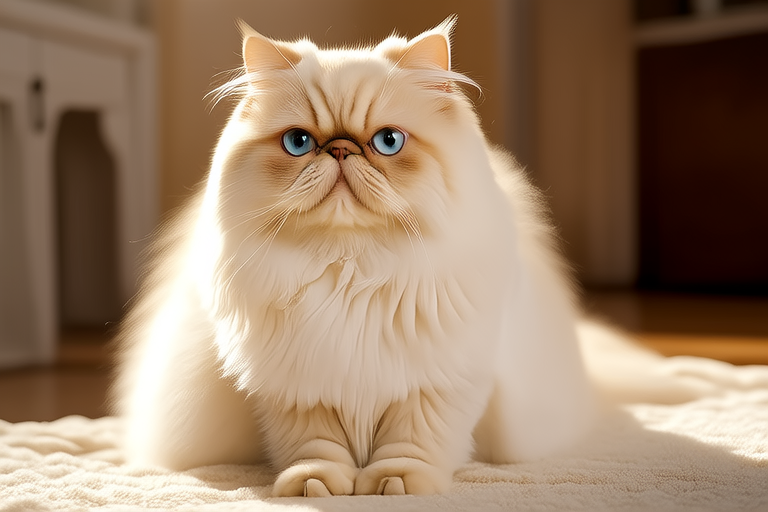The Allure of Persian Cats: A Journey Through Their Luxurious Coats
When it comes to feline elegance, few breeds can rival the regal presence of Persian cats. With their plush, flowing coats and serene demeanor, these cats have captivated the hearts of cat enthusiasts for centuries. This article delves into the unique characteristics, grooming needs, and historical background of Persian cats’ coats, highlighting genetic factors that influence coat texture and color variations. We will also explore expert opinions on maintaining the luxurious appearance of their fur, discuss common health issues related to their coats, and provide care tips to ensure your Persian cat remains as stunning as ever.
A Brief History of Persian Cats
The origins of Persian cats trace back to ancient Persia (modern-day Iran), where they were revered for their striking beauty. These cats were initially introduced to Europe by Italian traders during the 17th century. The breed gained popularity in England and France, where it became a symbol of luxury and refinement. Over time, selective breeding has refined the Persian cat’s coat, resulting in the silky, long-haired marvels we see today.
Unique Characteristics of Persian Cat Coats
Persian cats are known for their lush, dense coats that cascade down their bodies like flowing silk. Their fur is typically soft to the touch and can range from medium to extra-long in length. The coat’s texture is often described as plush, with a slight wave or curl, giving it an almost velvety feel. This unique texture is achieved through a combination of genetic factors, including the length and density of individual hairs, as well as the structure of the hair shaft.
One of the most distinctive features of Persian cat coats is their wide variety of colors and patterns. From solid whites and blacks to striking tabby patterns and exotic points, there is a Persian cat to suit every taste. The breed standard allows for over 80 different color combinations, making it one of the most diverse in terms of coat appearance.
Genetic Factors Influencing Coat Texture and Color Variations
The luxurious coats of Persian cats are the result of specific genetic factors. One of the key genes responsible for their long, silky fur is the longhair gene. This gene, which is recessive, ensures that both parents must carry it for their offspring to inherit the long hair trait. In addition to the longhair gene, several other genes contribute to the overall texture and appearance of the coat. For instance, the curling gene causes the fur to have a slight wave or curl, while the density gene determines how thick and plush the coat feels.
Color variations in Persian cats are influenced by multiple genes, including the extension gene, which controls the production of eumelanin (black pigment) and pheomelanin (red pigment). Other genes, such as the agouti gene and dominant white gene, further refine the expression of these pigments, leading to the wide array of colors and patterns seen in the breed.
Expert Opinions on Maintaining the Luxurious Appearance of Persian Cat Fur
To maintain the luxurious appearance of a Persian cat’s coat, regular grooming is essential. Experts recommend daily brushing to prevent matting and tangling, especially around the face, ears, and tail. Using a high-quality, slicker brush designed for long-haired cats can help remove loose hair and distribute natural oils throughout the coat. Additionally, many experts suggest incorporating a fine-toothed comb into the grooming routine to address any knots or tangles that may form between the fur.
Bathing is another crucial aspect of maintaining a Persian cat’s coat. While these cats are generally clean and fastidious about grooming themselves, occasional baths can help keep their fur soft and shiny. It’s important to use a gentle, pH-balanced shampoo specifically formulated for cats, and to thoroughly rinse out all soap residue to avoid skin irritation. Many experts also recommend conditioning treatments after bathing to add extra moisture and shine to the coat.
Common Health Issues Related to Persian Cat Coats
Despite their stunning appearance, Persian cats are prone to certain health issues related to their coats. One of the most common problems is fur mats, which can occur when the fur becomes tangled and compressed. If left untreated, these mats can lead to discomfort, skin infections, and even hair loss. Regular grooming is essential to prevent matting and ensure the cat’s comfort.
Another issue faced by Persian cats is tear staining, which occurs when tears accumulate around the eyes, leaving behind a reddish-brown stain. This condition is often exacerbated by long, droopy facial hair that traps moisture and bacteria. To combat tear staining, experts recommend wiping the area around the eyes daily with a damp cloth and applying a gentle eye wash if necessary. In some cases, dietary supplements containing omega-3 fatty acids may help reduce tear production and improve overall eye health.
Care Tips for Ensuring a Healthy and Luxurious Persian Cat Coat
To ensure your Persian cat maintains its luxurious coat, follow these care tips:
- Daily Grooming: Brush your cat’s coat at least once a day to prevent matting and distribute natural oils.
- Regular Baths: Bathe your cat every four to six weeks using a gentle, pH-balanced shampoo and conditioner.
- Eye Care: Wipe the area around your cat’s eyes daily with a damp cloth to prevent tear staining.
- Nutrition: Provide a balanced diet rich in essential nutrients to support healthy skin and coat.
- Veterinary Check-Ups: Schedule regular check-ups with your veterinarian to monitor your cat’s overall health and address any coat-related issues early.
The Enchantment of Persian Cats
The allure of Persian cats lies not only in their striking appearance but also in their gentle, affectionate nature. With their luxurious coats and captivating personalities, these cats have earned a special place in the hearts of cat lovers worldwide. By understanding the unique characteristics, grooming needs, and genetic factors influencing their coats, you can ensure your Persian cat remains as beautiful and healthy as the day you brought them home.
